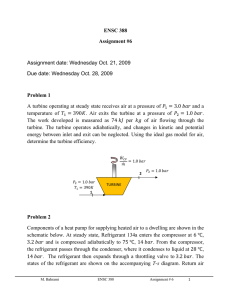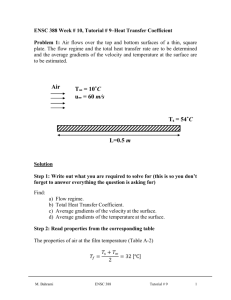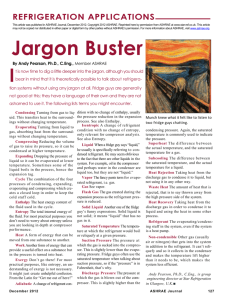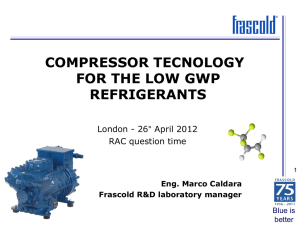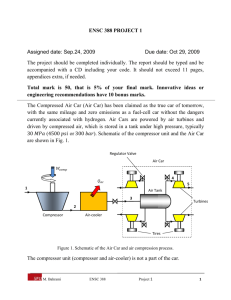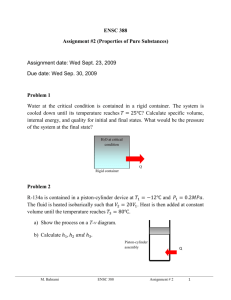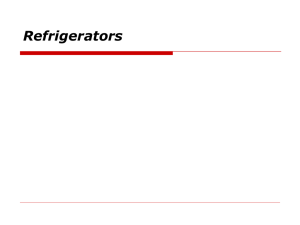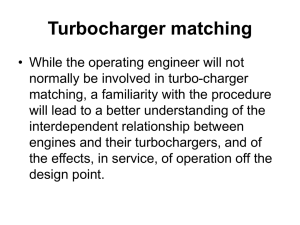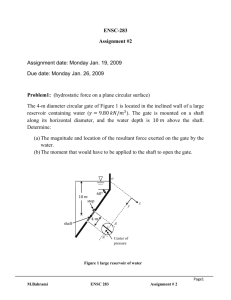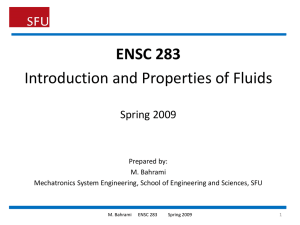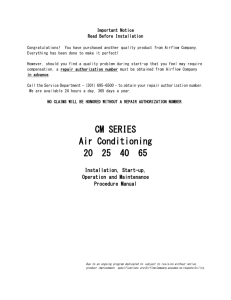Assignment6_solutions
advertisement
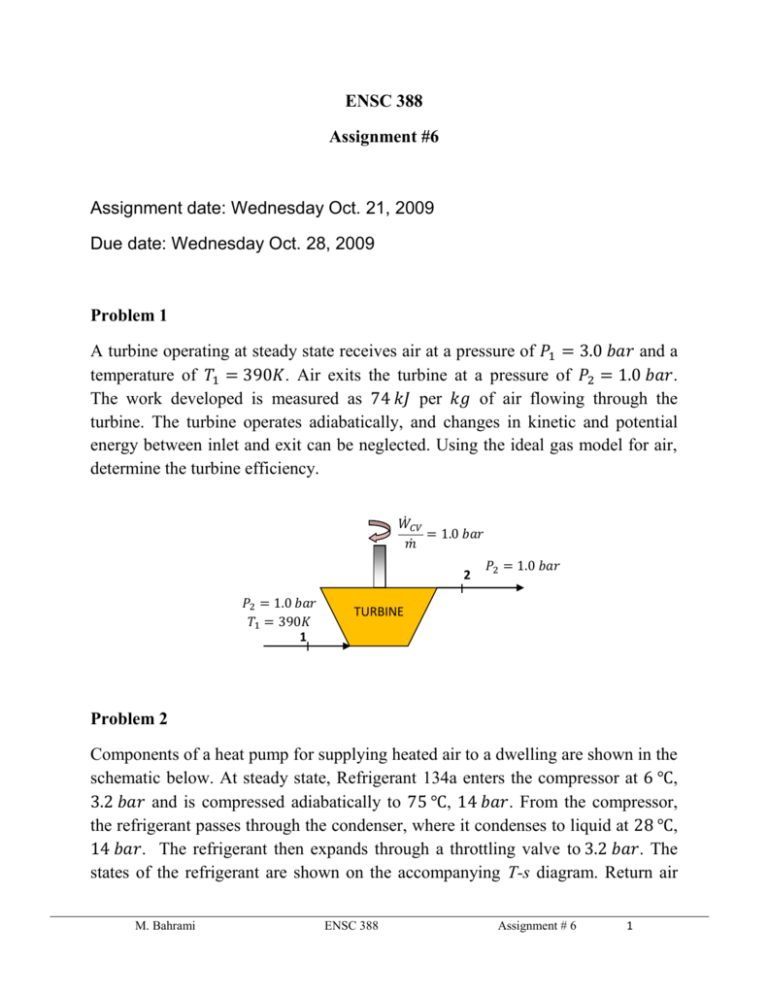
ENSC 388 Assignment #6 Assignment date: Wednesday Oct. 21, 2009 Due date: Wednesday Oct. 28, 2009 Problem 1 A turbine operating at steady state receives air at a pressure of 𝑃1 = 3.0 𝑏𝑎𝑟 and a temperature of 𝑇1 = 390𝐾. Air exits the turbine at a pressure of 𝑃2 = 1.0 𝑏𝑎𝑟. The work developed is measured as 74 𝑘𝐽 per 𝑘𝑔 of air flowing through the turbine. The turbine operates adiabatically, and changes in kinetic and potential energy between inlet and exit can be neglected. Using the ideal gas model for air, determine the turbine efficiency. 𝑊̇𝐶𝑉 = 1.0 𝑏𝑎𝑟 𝑚̇ 2 𝑃2 = 1.0 𝑏𝑎𝑟 𝑇1 = 390𝐾 1 𝑃2 = 1.0 𝑏𝑎𝑟 TURBINE Problem 2 Components of a heat pump for supplying heated air to a dwelling are shown in the schematic below. At steady state, Refrigerant 134a enters the compressor at 6 ℃, 3.2 𝑏𝑎𝑟 and is compressed adiabatically to 75 ℃, 14 𝑏𝑎𝑟. From the compressor, the refrigerant passes through the condenser, where it condenses to liquid at 28 ℃, 14 𝑏𝑎𝑟. The refrigerant then expands through a throttling valve to 3.2 𝑏𝑎𝑟. The states of the refrigerant are shown on the accompanying T-s diagram. Return air M. Bahrami ENSC 388 Assignment # 6 1 from the dwelling enters the condenser at 20 ℃, 1 𝑏𝑎𝑟 with a volumetric flow rate of 0.42 𝑚3 /𝑠 and exits at 50 ℃ with a negligible change in pressure. Using the ideal gas model for the air and neglecting kinetic and potential energy effects, (a) determine the rates of entropy production, in 𝑘𝑊/𝐾, for control volumes enclosing the condenser, compressor, and expansion valve, respectively. (b) Discuss the sources of irreversibility in the components considered in part (a). Indoor return air 𝑇5 = 20℃ 𝑃5 = 1 𝑏𝑎𝑟 (𝐴𝑉)5 = 0.42 𝑚3 /𝑠 Condenser 𝑇3 = 28℃ 3 𝑃3 = 14 𝑏𝑎𝑟 Expansion Valve 𝑃4 = 3.2 𝑏𝑎𝑟 4 Supply air 𝑇6 = 50℃ 𝑃6 = 1 𝑏𝑎𝑟 𝑇2 = 75℃ 𝑃2 = 14 𝑏𝑎𝑟 2 3 14 𝑏𝑎𝑟 28℃ Turbine 3.2 𝑏𝑎𝑟 1 Evaporator M. Bahrami 75℃ 2 T 𝑇1 = 6 ℃ 𝑃1 = 3.2 𝑏𝑎𝑟 1 6℃ 4 s Outdoor air ENSC 388 Assignment # 6 2 Problem 1: Known: 𝑆𝑡𝑎𝑡𝑒𝑠 𝑖𝑛𝑓𝑜𝑟𝑚𝑎𝑡𝑖𝑜𝑛 𝑎𝑛𝑑 𝑡ℎ𝑒 𝑝𝑟𝑜𝑐𝑒𝑠𝑠𝑒𝑠. Find: - Turbine efficiency. 𝑇 3 𝑏𝑎𝑟 1 𝑇1 = 390𝐾 Actual expansion Isentropic expansion 2s 2 1 𝑏𝑎𝑟 𝑠 Assumptions: - Problem is steady state. - The expansion is adiabatic and the changes in kinetic and potential energy between inlet and exit can be neglected. - The air is modeled as an ideal gas. Analysis: Isentropic turbine efficiency can be obtained from 𝑊̇𝐶𝑉 𝑚̇ 𝜂𝑡 = 𝑊̇ ( 𝑚𝐶𝑉 ̇ )𝑠 The numerator of the efficiency is known. The denominator is evaluated as follows. M. Bahrami ENSC 388 Assignment # 6 3 The work developed in an isentropic expansion from the given inlet state to the specified exit pressure is 𝑊̇𝐶𝑉 ( ) = ℎ1 − ℎ2𝑠 𝑚̇ 𝑠 From Table A-17, at 390𝐾, ℎ1 = 390.88 𝑘𝐽/𝑘𝑔. To determine ℎ2𝑠 , applying an exact solution leads to 𝑃2 𝑃𝑟 (𝑇2𝑠 ) = ( ) 𝑃𝑟 (𝑇1 ) 𝑃1 With 𝑃1 = 3 𝑏𝑎𝑟, 𝑃2 = 1 𝑏𝑎𝑟 and 𝑃𝑟 (𝑇1 ) = 3.481 form Table A-17 at 390𝐾 1 𝑃𝑟 (𝑇2𝑠 ) = ( ) × 3.481 = 1.1603 3 Interpolating in Table A-17 gives ℎ2𝑠 = 285.27 𝑘𝐽/𝑘𝑔. Thus 𝑊̇𝐶𝑉 𝑘𝐽 𝑘𝐽 𝑘𝐽 ( ) = 390.88 [ ] − 285.27 [ ] = 105.6 [ ] 𝑚̇ 𝑠 𝑘𝑔 𝑘𝑔 𝑘𝑔 Hence isentropic turbine efficiency will be 𝑘𝐽 74 [ ] 𝑘𝑔 𝜂𝑡 = = 0.7 𝑜𝑟 70% 𝑘𝐽 105.6 [ ] 𝑘𝑔 M. Bahrami ENSC 388 Assignment # 6 4 Problem 2: Known: 𝑆𝑡𝑎𝑡𝑒𝑠 𝑖𝑛𝑓𝑜𝑟𝑚𝑎𝑡𝑖𝑜𝑛 𝑎𝑛𝑑 𝑡ℎ𝑒 𝑝𝑟𝑜𝑐𝑒𝑠𝑠𝑒𝑠. Find: - The entropy production rates for control volumes enclosing the condenser, compressor, and expansion valve, respectively and discuss the sources of irreversibility in these components. Assumptions: - Each component is analyzed as a control volume at steady state. - The compressor operates adiabatically, and the expansion across the valve is a throttling process. - For the control volume enclosing the condenser, 𝑊̇𝐶𝑉 = 0 and 𝑄̇𝐶𝑉 = 0. - Kinetic and potential energy effects can be neglected. - The air is modeled as an ideal gas with constant 𝑐𝑝 = 1.005 𝑘𝐽/𝑘𝑔. 𝐾. Analysis: (a) Lets us begin by obtaining property data at each of the principal refrigerant states located on the T-s diagram. At the inlet to the compressor, the refrigerant is a superheated vapour at 6 ℃, 3.5 𝑏𝑎𝑟, so from Table A-13, 𝑠1 = 0.9415 𝑘𝐽/𝑘𝑔. 𝐾. Similarly, at state 2, the refrigerant is superheated vapour at 75 ℃, 14 𝑏𝑎𝑟, so interpolating in Table A-13 gives 𝑠2 = 0.9561 𝑘𝐽/𝑘𝑔. 𝐾 and ℎ2 = 291.3 𝑘𝐽/𝑘𝑔. State 3 is compressed liquid at 28 ℃, 14 𝑏𝑎𝑟. From Table A-11, 𝑠3 ≈ 𝑠𝑓@28 ℃ = 0.33846 𝑘𝐽/𝑘𝑔. 𝐾 and ℎ3 ≈ ℎ𝑓@28 ℃ = 90.69 𝑘𝐽/𝑘𝑔. The expansion through the valve is a throttling process, thus ℎ4 = ℎ3 . Using data from Table A-11, the quality at state 4 is 𝑥4 = M. Bahrami ℎ4 − ℎ𝑓@3.2𝑏𝑎𝑟 ℎ𝑓𝑔@3.2𝑏𝑎𝑟 𝑘𝐽 𝑘𝐽 90.69 [ ] − 55.16 [ ] 𝑘𝑔 𝑘𝑔 = = 0.18 𝑘𝐽 196.71 [ ] 𝑘𝑔 ENSC 388 Assignment # 6 5 And the specific entropy is 𝑠4 = 𝑠𝑓@3.2𝑏𝑎𝑟 + 𝑥4 𝑠𝑓𝑔@3.2𝑏𝑎𝑟 = 0.21637 [ 𝑘𝐽 𝑘𝐽 ] + 0.18 × 0.71369 [ ] 𝑘𝑔. 𝐾 𝑘𝑔. 𝐾 𝑘𝐽 → 𝑠4 = 0.3448 [ ] 𝑘𝑔. 𝐾 Condenser: Consider the control volume enclosing the condenser. With the first and third assumptions, the entropy rate balance reduces to 0 = 𝑚̇𝑟𝑒𝑓 (𝑠2 − 𝑠3 ) + 𝑚̇𝑎𝑖𝑟 (𝑠5 − 𝑠6 ) + 𝑠̇𝑔𝑒𝑛,𝑐𝑜𝑛𝑑 To evaluate 𝑠̇𝑔𝑒𝑛 requires the two mass flow rates, 𝑚̇𝑟𝑒𝑓 and 𝑚̇𝑎𝑖𝑟 , and the change in specific entropy for the air. These are obtained next. Evaluating the mass flow rate of air using the ideal gas model 𝑚̇𝑎𝑖𝑟 𝑃5 𝑚3 100[𝑘𝑃𝑎] 𝑘𝑔 = (𝐴𝑉)5 = 0.42 [ ] × = 0.5 [ ] 𝑘𝐽 𝑅𝑇 𝑠 𝑠 ⏟5 0.286 [ ] × 293 [𝐾] 𝑘𝑔. 𝐾 𝜌 The refrigerant mass flow rate is determined using an energy balance for the control volume enclosing the condenser together with the 1 st, 3rd and 4th assumptions to obtain 𝑚̇𝑟𝑒𝑓 = 𝑚̇𝑎𝑖𝑟 (ℎ6 − ℎ5 ) ℎ2 − ℎ3 With the 5th assumption, ℎ6 − ℎ5 = 𝑐𝑝 (𝑇6 − 𝑇5 ). Inserting values 𝑚̇𝑟𝑒𝑓 𝑘𝑔 𝑘𝐽 0.5 [ ] × 1.005 [ ] × (323[𝐾] − 293[𝐾]) 𝑘𝑔 𝑠 𝑘𝑔. 𝐾 = = 0.075 [ ] 𝑘𝐽 𝑘𝐽 𝑠 291.3 [ ] − 90.69 [ ] 𝑘𝑔 𝑘𝑔 The change in specific entropy of the air is M. Bahrami ENSC 388 Assignment # 6 6 𝑠6 − 𝑠5 = 𝑐𝑝 𝑙𝑛 𝑇6 𝑃6 𝑘𝐽 323[𝐾] 1[𝑏𝑎𝑟] − 𝑅𝑙𝑛 = 1.005 [ − 𝑅 𝑙𝑛 ] × 𝑙𝑛 𝑇5 𝑃5 𝑘𝑔. 𝐾 293[𝐾] ⏟ 1[𝑏𝑎𝑟] 0 → 𝑠6 − 𝑠5 = 0.098 [ 𝑘𝐽 ] 𝑘𝑔. 𝐾 Finally, solving the entropy balance for 𝑠̇𝑔𝑒𝑛 and inserting values 𝑠̇𝑔𝑒𝑛 = 𝑚̇𝑟𝑒𝑓 (𝑠3 − 𝑠2 ) + 𝑚̇𝑎𝑖𝑟 (𝑠6 − 𝑠5 ) 𝑘𝑔 𝑘𝐽 𝑘𝐽 𝑘𝑔 ] × (0.33846 [ ] − 0.9561 [ ]) + 0.5 [ ] 𝑠 𝑘𝑔. 𝐾 𝑘𝑔. 𝐾 𝑠 𝑘𝐽 𝑘𝑊 × 0.098 [ ] = 2.677 × 10−3 [ ] 𝑘𝑔. 𝐾 𝐾 𝑠̇𝑔𝑒𝑛,𝑐𝑜𝑛𝑑 = 0.075 [ Compressor: For the control volume enclosing the compressor, the entropy rate balance reduces with the first and third assumptions to 0 = 𝑚̇𝑟𝑒𝑓 (𝑠1 − 𝑠2 ) + 𝑠̇𝑔𝑒𝑛,𝑐𝑜𝑚𝑝 or 𝑘𝑔 𝑘𝐽 𝑘𝐽 𝑠̇𝑔𝑒𝑛,𝑐𝑜𝑚𝑝 = 𝑚̇𝑟𝑒𝑓 (𝑠2 − 𝑠1 ) = 0.075 [ ] × (0.9561 [ ] − 0.9415 [ ]) 𝑠 𝑘𝑔. 𝐾 𝑘𝑔. 𝐾 𝑘𝑊 = 1.095 × 10−3 [ ] 𝐾 Valve: Finally, for the control volume enclosing the throttling valve, the entropy rate balance reduces to 0 = 𝑚̇𝑟𝑒𝑓 (𝑠3 − 𝑠4 ) + 𝑠̇𝑔𝑒𝑛,𝑣𝑎𝑙 Solving for 𝑠̇𝑔𝑒𝑛,𝑣𝑎𝑙 and inserting values M. Bahrami ENSC 388 Assignment # 6 7 𝑠̇𝑔𝑒𝑛,𝑣𝑎𝑙 = 𝑚̇𝑟𝑒𝑓 (𝑠4 − 𝑠3 ) = 0.075 [ 𝑘𝑔 𝑘𝐽 𝑘𝐽 ] × (0.3448 [ ] − 0.33846 [ ]) 𝑠 𝑘𝑔. 𝐾 𝑘𝑔. 𝐾 𝑘𝑊 = 4.755 × 10−4 [ ] 𝐾 (b) The following table summarize, in rank order, the calculated entropy production rates 𝒌𝑾 ] 𝑲 compressor 1.095 × 10−3 valve 4.755 × 10−4 condenser 2.677 × 10−3 Component 𝒔̇ 𝒈𝒆𝒏 [ Entropy production in the compressor is due to fluid friction, mechanical friction of the moving parts, and internal heat transfer. For the valve, the irreversibility is primarily due to fluid friction accompanying the expansion across the valve. The principal source of irreversibility in the condenser is the temperature difference between the air and refrigerant streams. In this problem, there are no pressure drops for either stream passing through the condenser, but slight pressure drops due to fluid friction would normally contribute to the irreversibility of condensers. The evaporator lightly has not analyzed in this solution. Note (1): Since the temperature difference is large in problem one, applying approximate solution may leads to considerable error. Try to apply the approximate solution and see how different the result is. Note (2): Due to relatively small temperature change of the air, the specific heat 𝑐𝑝 can be taken constant at the average of the inlet and exit air temperature. Note (3): Temperature in 𝐾 are used to evaluate 𝑚̇𝑟𝑒𝑓 , but since a temperature difference is involved the same result would be obtained if temperature in ℃ were used. Temperatures in 𝐾 must be used when a temperature ratio is involved. M. Bahrami ENSC 388 Assignment # 6 8
